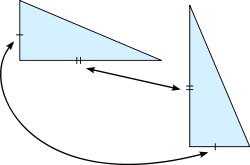Hatch mark
Hatch marks, sometimes also called hash marks, or tick marks, are a form of mathematical notation. They are typically used three ways:
- Unit and value marks – as on a ruler or number line.
- Congruency notation – as on a geometric figure.
- Graphed points – as on a graph.
Hatch marks are frequently used as an alternate form of abbreviation for some common units of measurement. In regard to distance, a single hatch mark typically indicates feet and a double hash mark indicates inches within the English system. In regard to time, a single hatch mark indicates minutes and a double hatch mark indicates seconds; these typically occur following hours, indicated by an elevated circle. The same system is used within Geometry and Trigonometry for the measurement of angles in degrees, minutes and seconds.
Unit and value marks
Every ruler or number line that uses vertical line segments to mark distance values is using unit & value hatch marks. The marks appear as single vertical line segments that are parallel to each other and evenly spaced. This distance between each mark is one unit. Each mark has a value at that location. The length of the segment is usually an indication of the size of the value. For example, longer line segments are usually used for integers (or just natural numbers). Shorter line segments are usually used for fractions. The hatch mark pattern on the ruler or number line gives the viewer a visual clue as to the value at a certain point on the number line, even if all the hatch marks do not have labels.
<----|----|----|----|----|----|----|----|----|----|----|----|----|---->
-3 -2 -1 0 1 2
This type of usage of hatch marks falls in the range of number theory and geometry. It is here that the term hatch marks is interchangeable with hash marks or tick marks.
Congruency notation

In geometry, the notation for equal measure of angles, arcs, line segments, or other elements of a diagram is hatch marks. They are short line segments used in a pattern to indicate relationship, specifically congruency.
Hatch marks for congruency notation are in the style of tally marks or of Roman numerals – with some qualifications. These marks are without serifs and some patterns are not used. For example, the numbers I, II, III, V, and X are used, but IV and VI are not used since a rotation of 180 degrees can make a 4 easily confused with a 6.
Considering the close relationship of geometry to art, hatch marks can probably be traced to hatching in which the pattern of the marks is representative of a unique tone or hue with different patterns indicating different tones. Likewise in geometry, each hatch pattern is representative of a unique value. When hatch marks match, measurement values for the two items are the same.
For example, if two triangles are drawn, the first pair of congruent sides can be marked with a single hatch mark on each. The second pair of congruent sides can be marked with two hatch marks each. The patterns are not alike: one pair uses one mark while the other pair uses two marks (Figure 1). This use of pattern makes it clear which sides are the same length even if the sides cannot be measured. If the sides do not appear to be congruent, as long as hatch marks are present and are the same number of hatch marks then the sides are congruent.
Graphed points
Line charts may sometimes use hatch marks as graphed points. In the early days of computers, monitors and printers could only make charts using the characters available on a common typewriter. To graph a line chart of sales over time, symbols such as *, x, or | were used to mark points and various characters were used to mark the lines connecting them. While computers have advanced considerably, it is still not unusual to see x or | used as the points of interest or points of change on a graph.